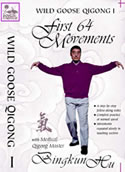Dayan (Wild Goose) Qigong Exercises
Bibliography, Links, Quotes, Notes, List of Movements
Research by Mike Garofalo
The Wild Goose Qigong form is one long continuous sequence of movements, much like a Taiji form. There are many aspects of the Wild Goose Qigong system as presented by Dr. Bingkun Hu of San Francisco.
"Wild Goose Qigong claims that “there are no intentional movements without
awareness. Wild Goose Qigong
advocates “wu-wei” (or “doing nothing”) and “tuo-yi” (“reduce one’s awareness to
the minimum”). A good
example is Wild Goose-1 (the first 64 Movements). We often tell our beginning
learners that the movements in
this set of qigong are supposed to describe the daily activities of a wild
goose. There are three parts to this qigong.
Part One is “The Goose Wakes Up”. It stretches itself, it brushes up its wings
and shakes them. It plays innocently.
A made-up story is even included: “Then the goose looks at the moon, which is
reflected in the water and tries to scoop it up."
Part Two is “The Flying Goose”. Flapping its wings, the care-free wild
goose skims over a smooth lake. It looks at the
water and dips down to drink the water. Then the goose is playing with he
“qi”. It tries to grasp the qi. It holds and
rotates the qi-ball. It pushes out the dirty qi, and tries to receive the
fresh qi from its lower back. In Part Three, the
goose is first flying up into the sky. Now it is flying over the water.
Then it is looking for some food. After that, it is
looking for its nest. At last, the goose goes to sleep. When beginning,
learners are encouraged to be pre-occupied
with the daily activity of an innocent wild goose, when they are imagining that
they are “flapping their wings” beside
shimmering lake under a full moon, their heart beat will be naturally slow down,
and their mind will gradually be quieting
down too. At the same time, they will be more responsive to the instructor’s
words on how to relax themselves through
the shifting of body weight. Wild Goose Qigong is a medical qigong. We practice
it because of its health benefits. When
we have better qi flow, our blood circulation will improve. We will have more
oxygen supply to our brain. Our mind will
be more alert. We will get stronger, and we will have more physical strength,
etc.."
- Bingkun Hu, Ph.D., A Safe and Delightful Approach to Good Health
- Bingkun Hu, Ph.D., A Safe and Delightful Approach to Good Health
"In Ancient Egypt as well as in Ancient China the goose was considered a messenger between Heaven and Earth. In China geese are still a symbol of marriage, because of their lifelong pair-bond. In the Roman empire, the goose was the sacred animal of Juno, a goddess of light, marriage and childbirth, who was later considered adviser and protectress of the Roman people. A story tells of how geese saved the Romans with their warning cries when the Gauls attacked the citadel of the Capitol. The Celts associated the goose with war, possibly because of its watchful nature and aggressive temperament. Warrior gods were sometimes depicted with geese as companions. Remains of geese have been found in warrior's graves. The Britons kept geese, but did not eat them. They were, however, sometimes used as sacrificial offerings. The goose, with its steady, powerful flight and migratory habits, can be associated with travelling, undertaking a journey to a new destination. This journey can be difficult and may take long. The goose can help people find the perseverance needed to go on with their quests. In earlier times, shamans were aided by spirit geese on their journeys to other worlds."
- Geese - The Animal Files


No comments:
Post a Comment